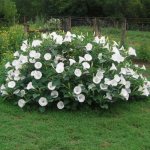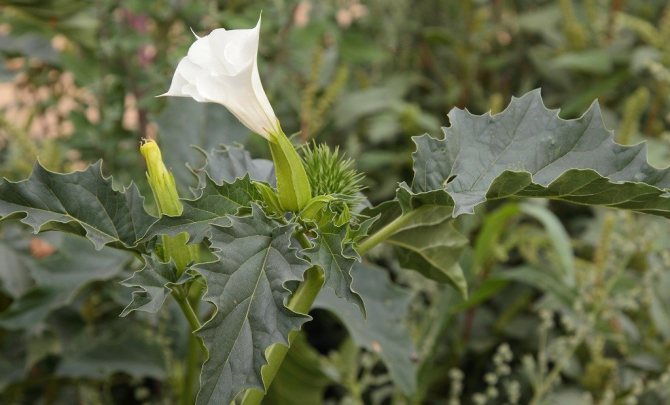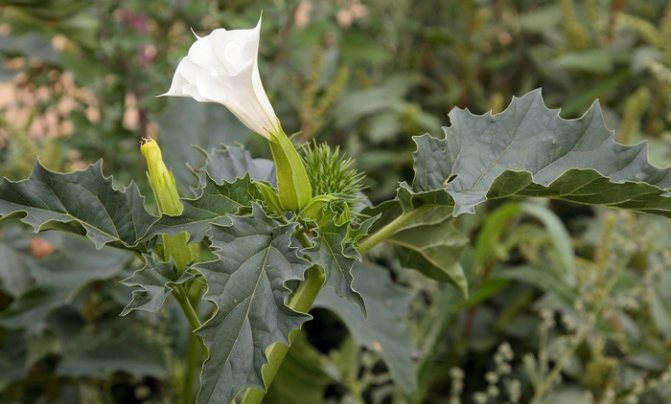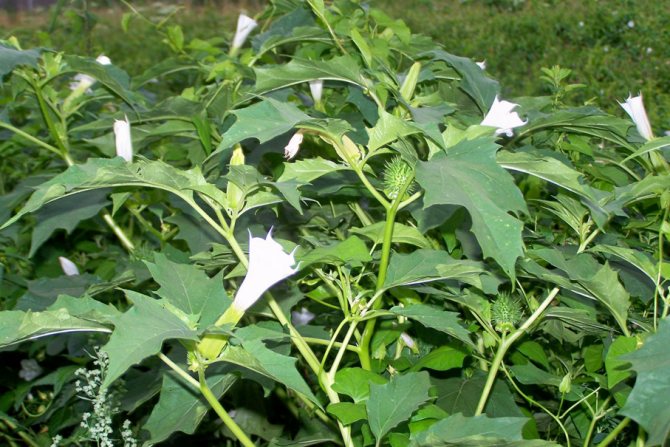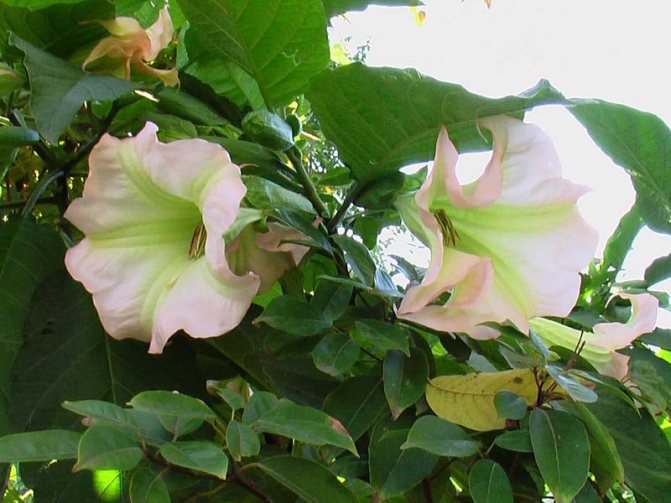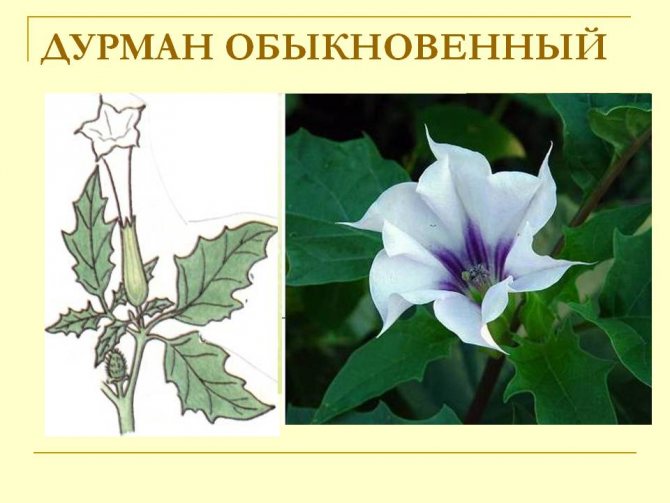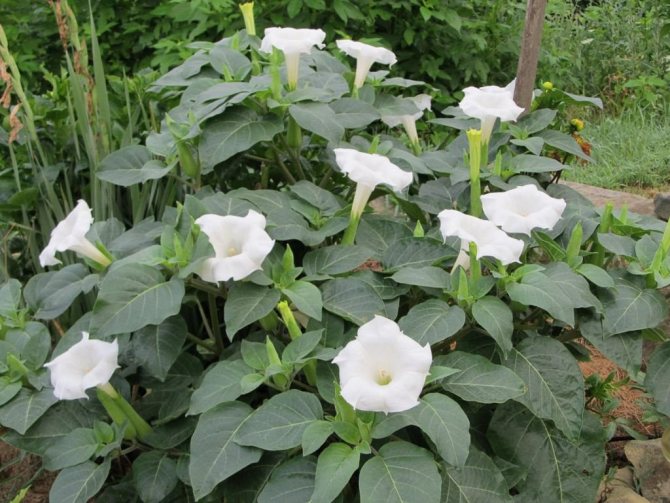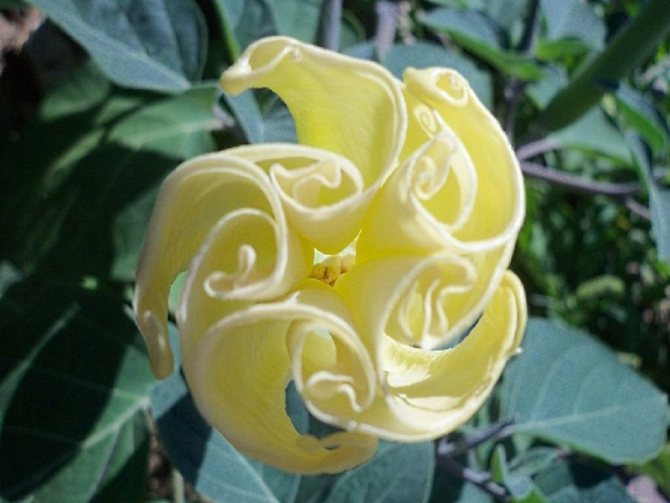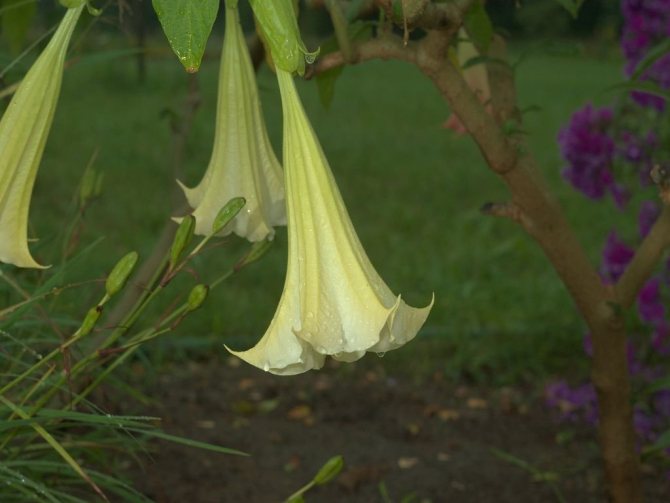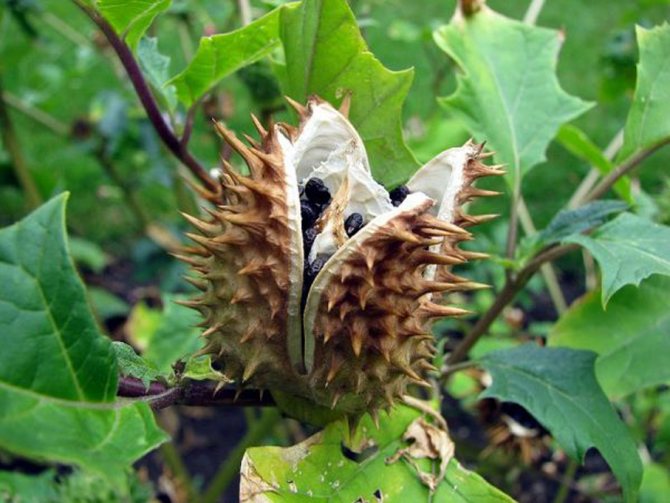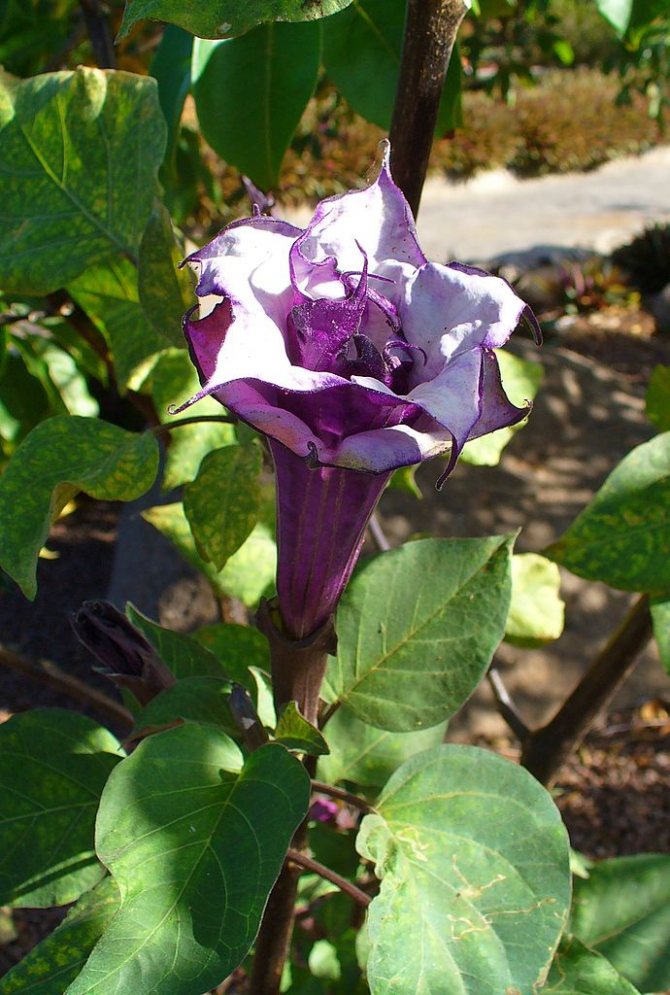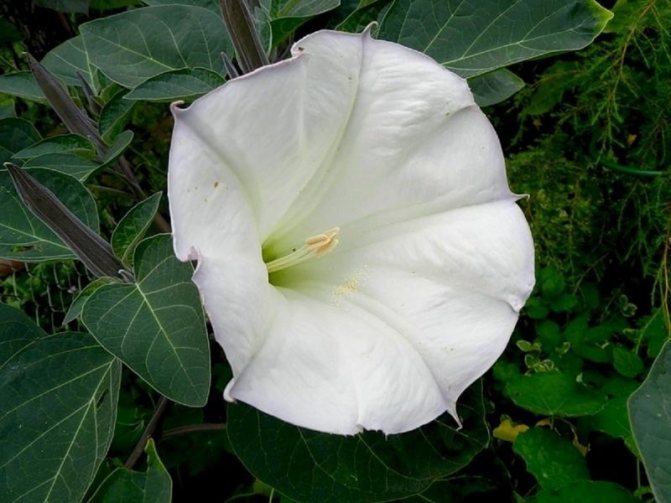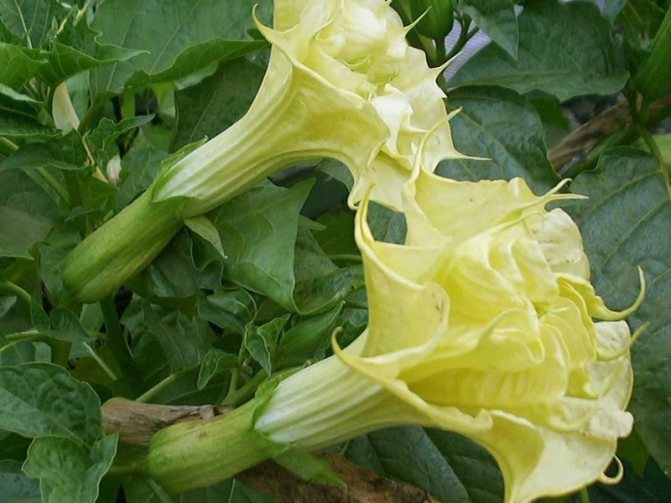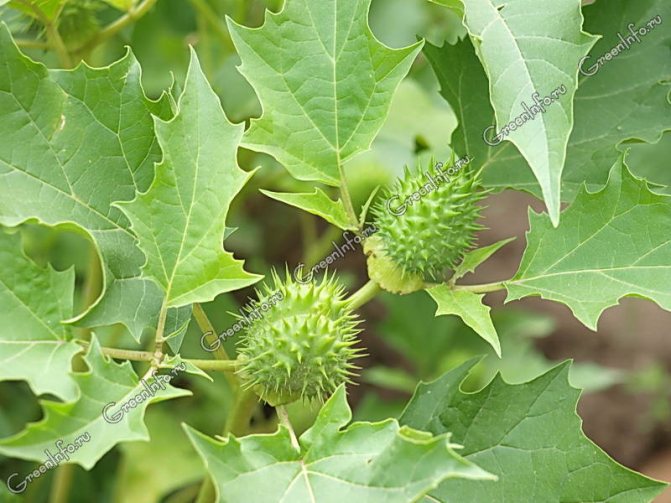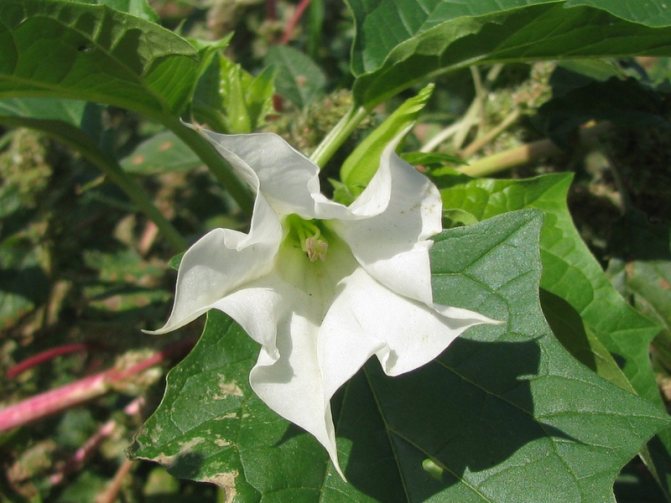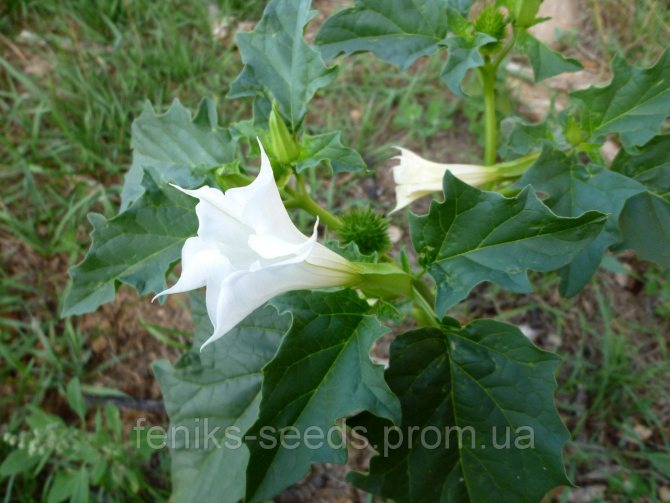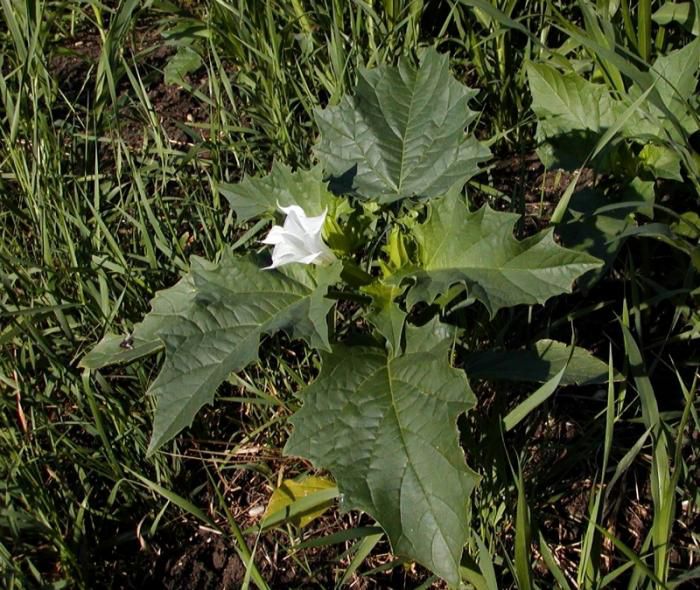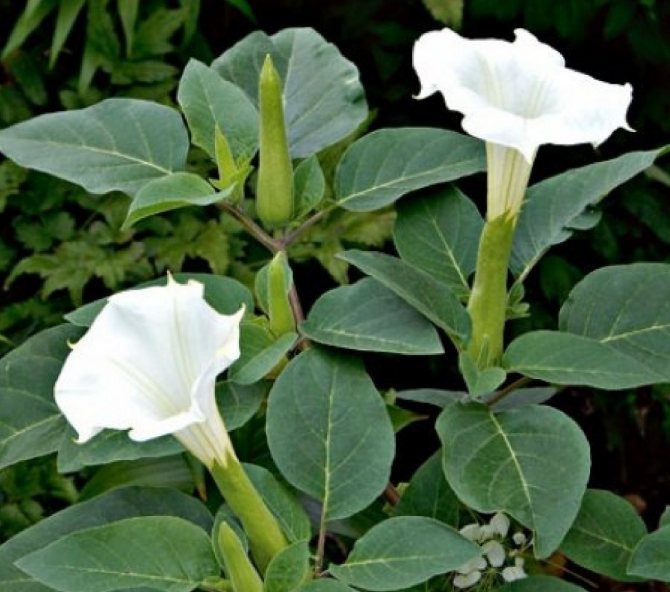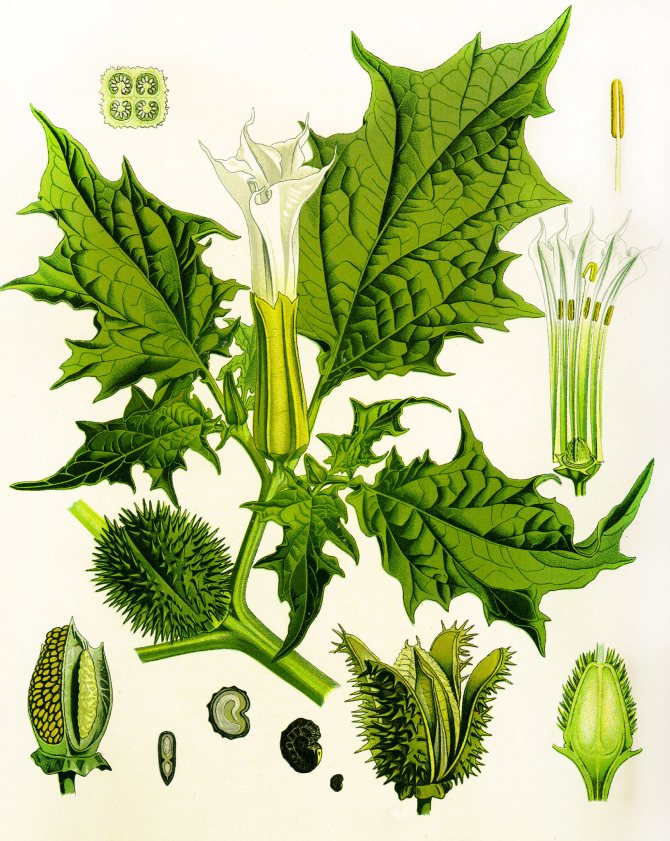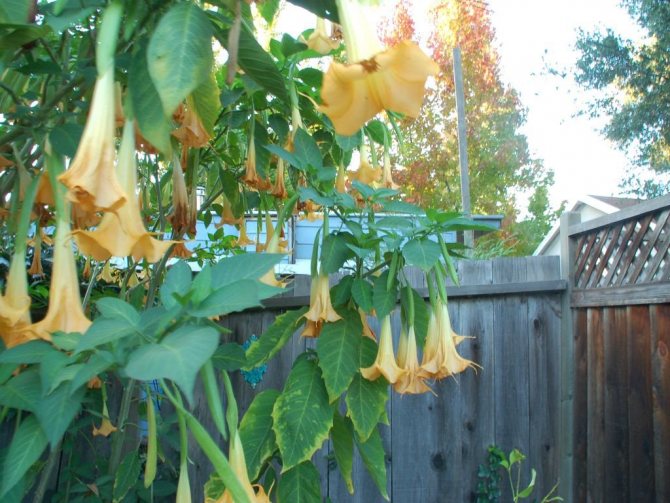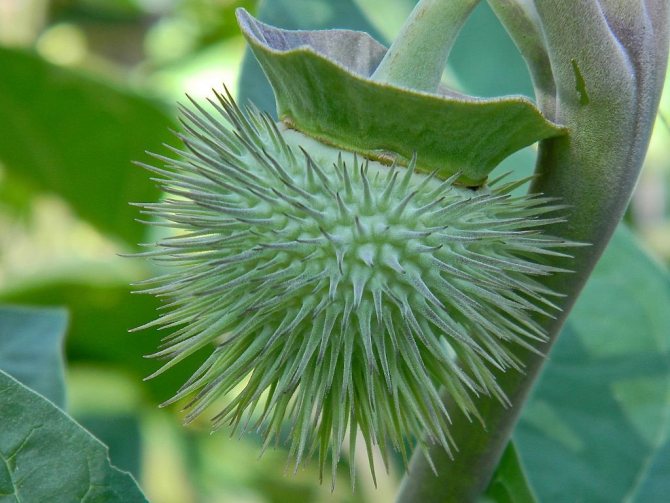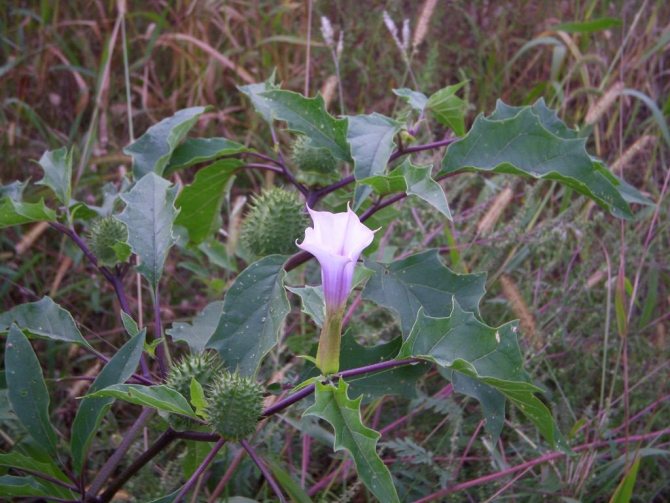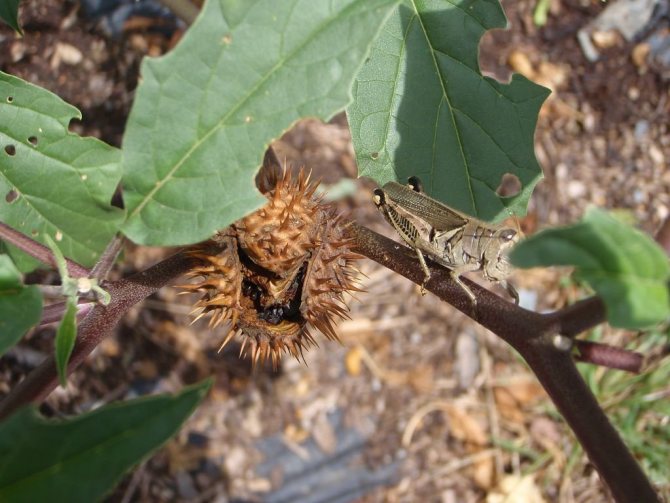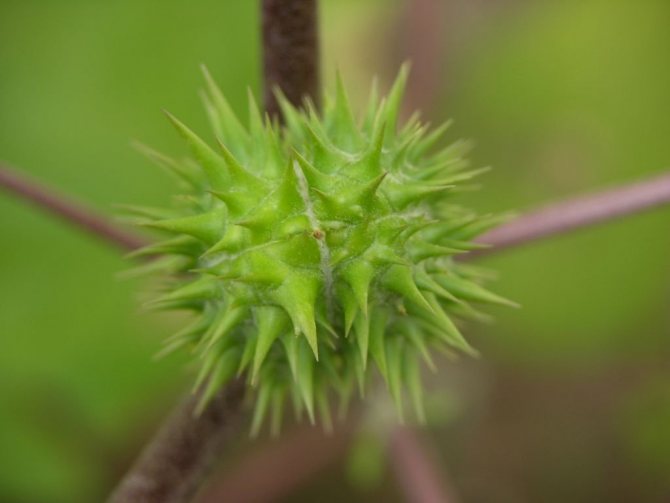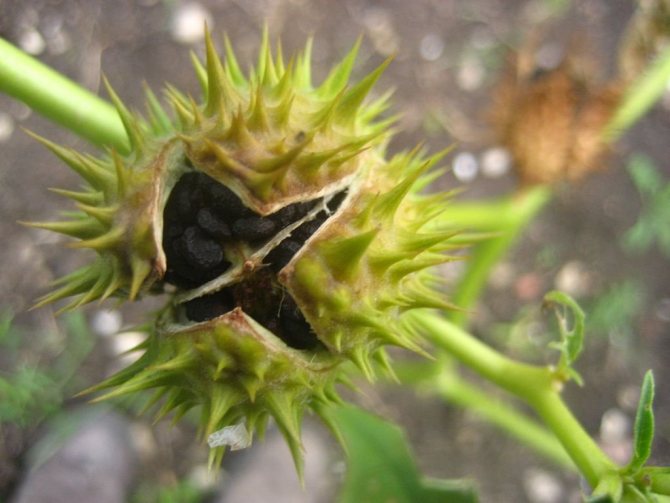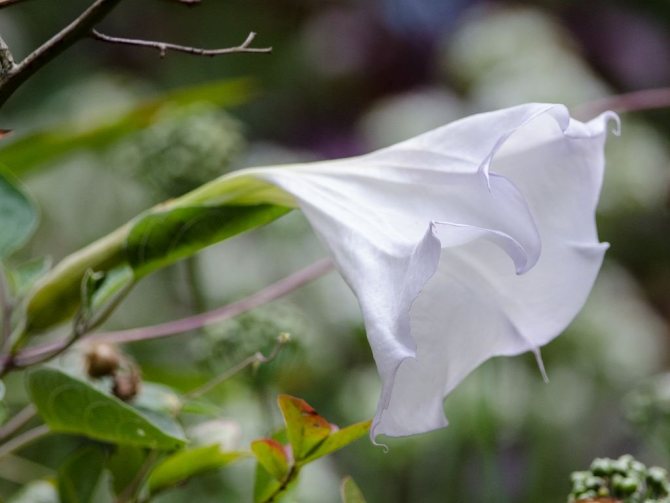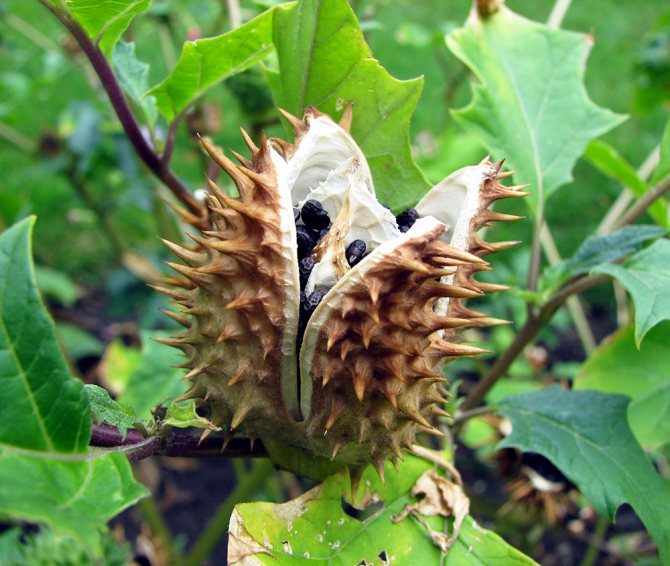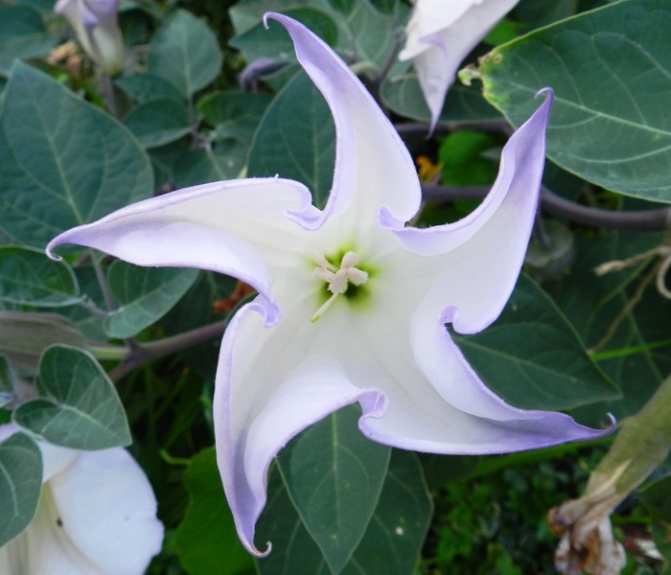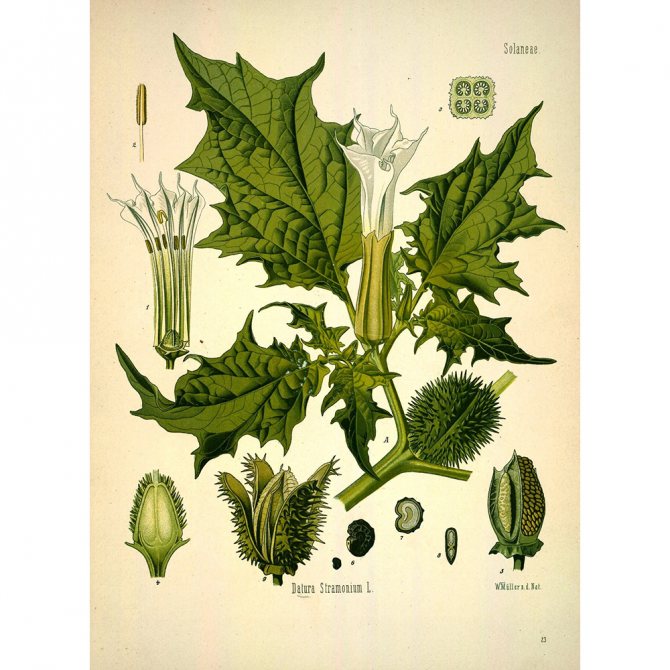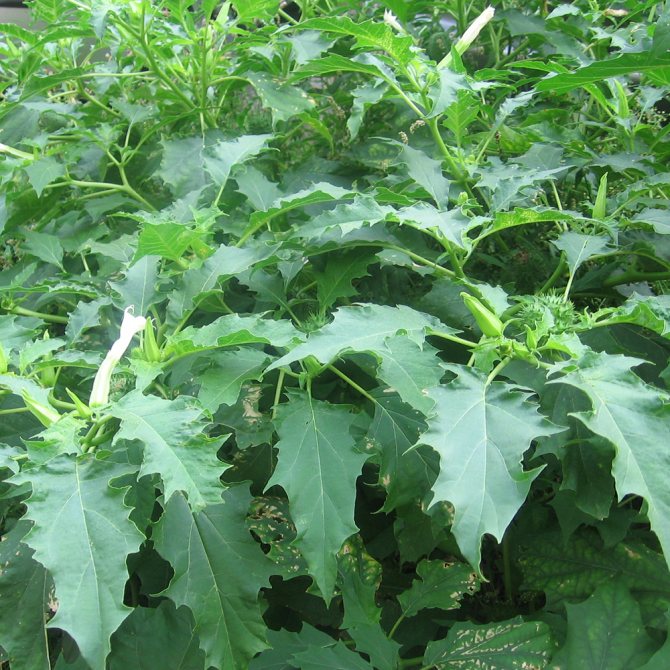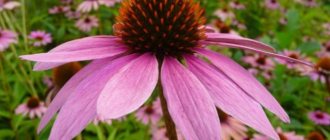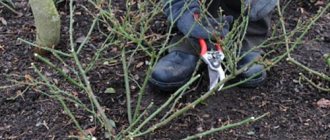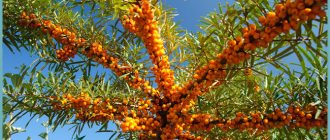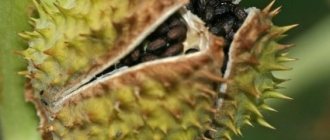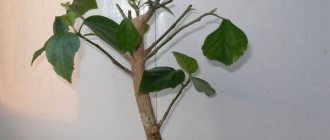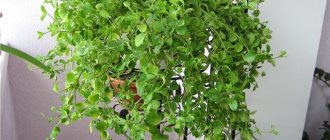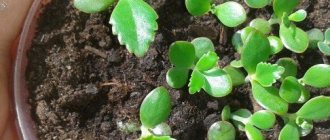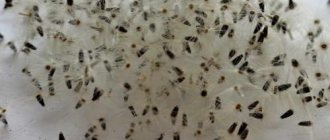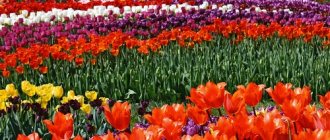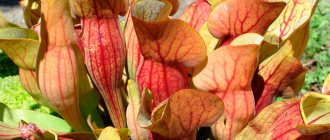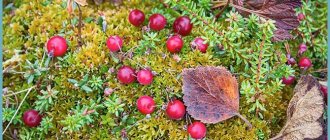Datura has accompanied humanity since ancient times. Having attracted attention with the beauty and aroma of its flowers, it became in demand and gradually revealed to people all its valuable properties.
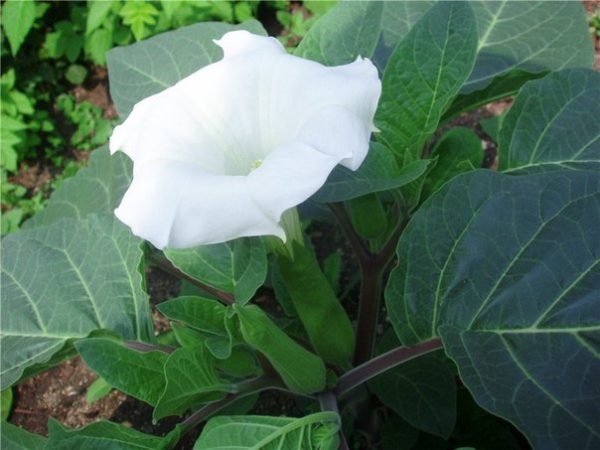
It looks like a garden dope
The description of this flower is found in many countries. In ancient Mexico, priests with its help fell into ecstasy, communicated with spirits and performed ritual ceremonies. In India, datura was used as a murder weapon and the science of killing with its help was specially trained.
Europeans discovered a lot of medicinal properties in this plant and already in the XIV century were used as an anesthetic in surgery. Later, vasoconstrictor and anticonvulsant substances were isolated from it, and today dope is grown from seeds in special fields as a medicinal culture for the needs of pharmacology.
Datature on a personal plot.
Datura is quite common in household plots. It is appreciated by gardeners for its extraordinary decorativeness, aroma and easy care.
Appearance
It is an incredibly beautiful annual plant. It reaches a height of 1 meter, but sometimes it will melt even higher. Datura plant has an ordinary taproot, wide, fusiform, has a large number of branches. Its stem is branched, erect, hollow inside. The twigs are covered with a small fluff. The leaves are serrated, large, notched, pointed, petiolate, ovate. Flowers of five white petals reach a length of 10 centimeters and always grow one at a time. They resemble a bell in appearance and have an unpleasant and strong aroma that intoxicates. The fruits of the Datura grass are a small oval box, densely covered with thorns. It contains up to eight hundred round, black, flattened seeds.
Retreat for Parents and Responsible Persons
Probably no one needs to be convinced that kids are interested in everything. Datura-grass attracts them with its appearance. Large leaves, magnificent flowers want to "explore". And this thought is ripening in the heads of not only the smallest "naturalists". Children up to seven years old (or even older) do not give up the infant habit of tasting everything. But if the kids, without hiding, pull everything into their mouths, then the "educated" kids will try to stealthily bite the object they like. Ask them if in doubt. It is clear that in the described plant they can be attracted by fruits and flowers. Datura is dangerous and poisonous. It's not something to try - it's not even recommended to take individual parts in your hands. Therefore, you need to watch your children if there is a dope-grass nearby. Don't be frivolous about this situation. In addition to its own substances, the plant also absorbs nitrates from the soil. Contact with him can cost the child health. Better to beware than to “work for a pharmacy” and reproach yourself for being hindsight.
Place of growth
Datura ordinary, the photo of which is given in this article, despite its beauty, is common in natural conditions as a weed. It usually grows along roadsides, on wastelands, river banks, landfills, in gardens and orchards, near houses. Habitat - Central Asia, the European part of Russia, Georgia, the Caucasus, Ukraine, Crimea, the Far East and Western Siberia.Datura prefers loose, nitrogen-rich soil and warm climates, although it also tolerates drought well.
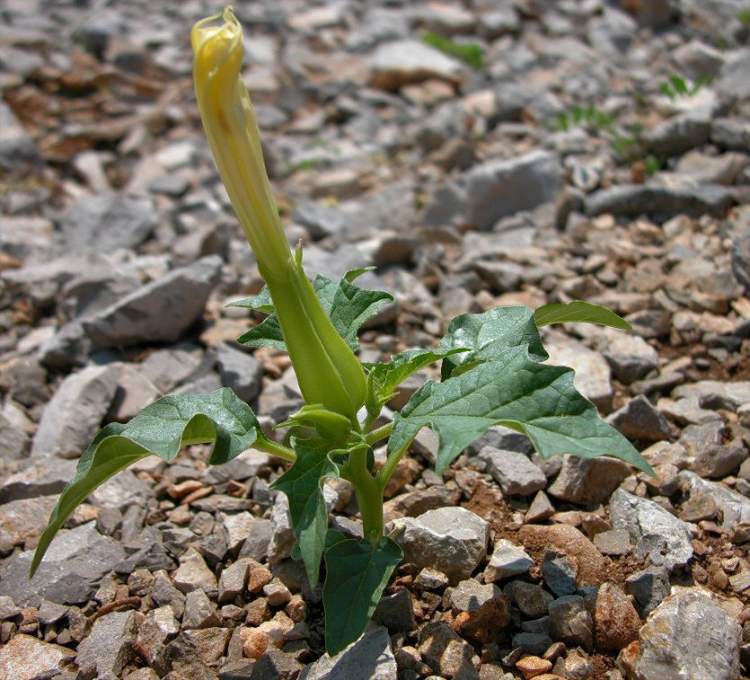

Gallery: common dope (25 photos)
Plant composition
A full description of the common dope plant is impossible without mentioning what useful elements it contains. It includes:
- potassium, calcium, magnesium, iron, sodium;
- vitamin C;
- oleic, linoleic, stearic, palmitic and other acids;
- copper, fluorine, zinc;
- essential oil;
- tannins;
- carotene;
- fatty oil;
- protein, etc .;
- alkaloids (hyoscyamine, atropine, daurin, scopolamine, etc.).
What does Datura grass look like and where does it grow: photo, video and description
Datura ordinary - Datura stramonium L. - woody shrub or herbaceous light green plant from the Solanaceae family, having an unpleasant odor, with a fusiform white root. Another name is brugmansiya.
The stem is erect, 15 to 80 cm high, thick, branched at the top into 3 equal branches. In rooms it can reach 1 - 1.5 m. The leaves are simple, pubescent, alternate, with long petioles, dark green above, grayish green below. When describing the Datura plant, it is especially worth noting its large, drooping, long-tubular flowers, as a rule, of white color. The flowers are kept on short pedicels located in the axils of the stem and branches. The fruit is a four-celled, and at the top is a two-celled capsule, covered with thorns on the outside.
These photos show what dope looks like:
Datura ordinary is found in Eurasia, North Africa, North and South America. For the temperate zone of Europe and Asia, the species D. stramonium (common dope) is characteristic, D. tatula grows in Iran. Another species, D. innoxia, originally from Mexico, is widely used in folk medicine and religious rites of the Indian tribes of Central America.
In Russia, it grows in the steppe zone of the European part, in the southern regions of Siberia and the Far East. Where dope grows, there is always a person's dwelling nearby. It can be found near cattle yards, on dung and garbage heaps, under fences, near housing, in abandoned cattle camps, along the banks of water bodies, in landfills. It grows like a weed near roads, in wastelands, sometimes forming thickets.
The species growing in the tropics and subtropics are used to obtain scopolamine. In some places, Datura is cultivated as an ornamental plant.
Datura flower is poisonous, but its name is a botanical curiosity: in translation it means "harmless dope."
Watch the video "Datura herb and its properties":
Types and varieties.
D. harmless (D.inoxia) - delicate pure white flowers with a light blue calyx;
D. snow-white (D. Candida); D. treelike (D. arborea);
D. fragrant, or fragrant (D. suaveolens) - fragrant flowers appear in late summer, autumn;
D. green-flowered (D. chlorantha), D. Indian (D. metel)
D. Indian ‘Alba’ (D. metel “Alba”), D. blood-red (V. sanguinea) - in winter and by the beginning of spring blooms with orange flowers; D. ordinary (B. stramonium).
Here's how to grow Datura at home.
Pharmacological properties
Since the plant contains hyoscyamine, it:
- has a bronchodilator effect;
- helps to block the activity of cholinergic systems in the human body;
- reduces the secretion of the salivary, gastric and sweat glands;
- tones up the respiratory system well;
- reduces the overall muscle tone.
Datura grass in a pharmacy can be found in almost any. It is actively used as a variety of extracts and tinctures.
Datura in the garden
In addition to ordinary dope, there are decorative species. They are used to decorate flower beds and garden plots.
Varieties are used as decorative:
- Flore Pleno. It dissolves double purple flowers with yellow dots inside.
- Ballerina. Inflorescences in the form of accrete funnels of 2-3 rows, from purple to light yellow.
- Inermis. Complete absence of thorns on fruits.
- Medea. Large snow-white flowers 20-25 cm long.
- Tatula. Small inflorescences of lilac-blue color.
Due to its abundant flowering, decorative dope won the recognition of gardeners.The fragrant aroma of the plant will mask the unpleasant odor from the sump or compost heap. The decorative properties of the grass are used in flower beds and front gardens.
Agricultural use
The herb is actively used in the form of an insecticidal preparation, which is necessary in agriculture to combat various pests. It can get rid of cabbage moths, hawthorn caterpillars, herbivorous bugs and ticks. Fresh leaves of the plant are added to the piglets' feed to increase the fat in the meat, while the dope tincture is used for animal cramps.
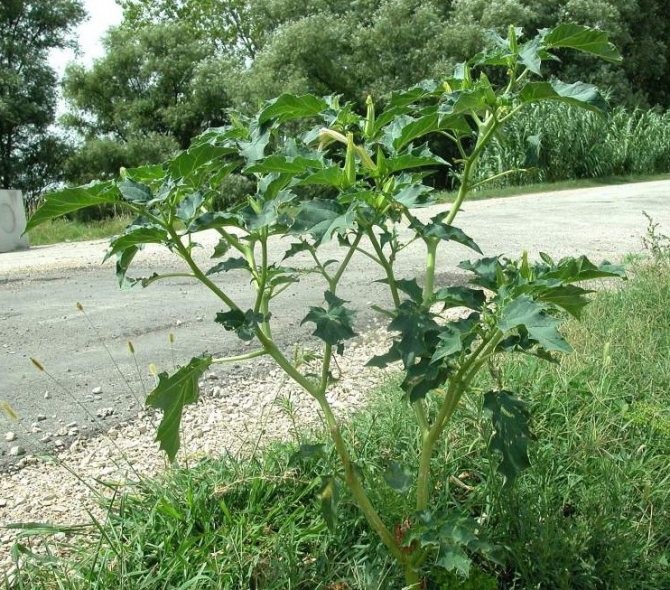

How to propagate
For propagation, cuttings are used. Shoots are cut at the end of September. There should be 2-3 internodes on the cut. The lower leaves are removed. You can root in water or potting soil, with good lighting and a temperature of at least 20 degrees.
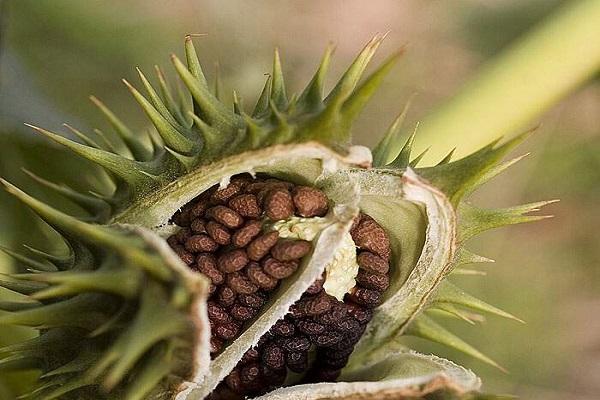

In mid-May, rooted cuttings are planted. Seedlings are planted with the ground by the transshipment method. The previously watered plant is removed from the container and transferred to the prepared hole. Sprinkled with earth and watered again.
Healing properties
Despite the dangers of using a high dose, the health properties of Datura are very beneficial. The plant has soothing, antispasmodic, analgesic properties.
It reduces intestinal secretion, as well as slows down the digestive processes, heals diseases of the biliary tract and gastrointestinal tract. Stomach cramps go away very quickly. Helps with diseases of the colon and uterine prolapse.
Datura ordinary expands the bronchial muscles, relaxes, heals diseases of the lymph nodes, convulsive cough and asthma, diseases of the upper respiratory tract. To eliminate asthma symptoms, the leaves of the herb are used in the form of smoking. It is used for epilepsy, shortness of breath, hiccups, spasms. In case of inflammation of the mouth and throat, toothache, rinsing with broth should be done.
Tinctures are created for stress, sleep disturbances, nervous system, mental illness, neurasthenia, and motion sickness. Datura treats speech disorders and seizures with ease. For bruises, rheumatism and eczema, compresses and baths using the plant are recommended. For all sorts of eye inflammations, light lotions are made from a decoction of the herb.
Datura common in the intimate area helps with painful tension of the penis and increased sexual arousal. In addition, it must be used for inflammation of the genitals and ovaries, mastitis and mastopathy. It is also used as a traditional medicine for whooping cough.
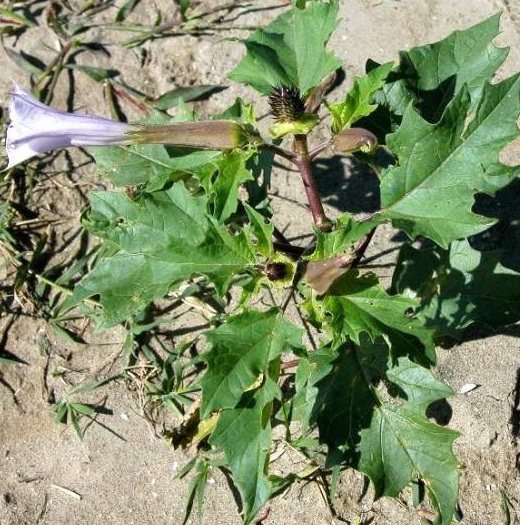

In microscopic quantities, it can be given to children at least 6 years old. Moreover, the symptoms for its use are the same as in adults.
Some interesting things from history
Datura-grass was revered by almost all Indian tribes in Central and South America. They learned in a peculiar way, taking into account their own beliefs, to use its poisonous properties, so to speak, for the good. The Aztecs, for example, chewed leaves to go into a trance. This was not done to get pleasure from drug intoxication, no. In this way, they solved the problems that arose. The Indians believed that in such a state they would be able to open the veil of secrecy and obtain the necessary information. They usually asked about who stole a certain thing, whether it can be returned, where it is. Still, using ordinary dope, they tried to get information regarding personal life, as well as health. A person who tasted parts of a poisonous plant was visited by hallucinations of various kinds. Some saw pictures, others heard voices, some went “on a journey across the astral plane”. However, researchers confirm that intoxication has been shown to have positive results. Things were found, betrayal was revealed, and so on. Flowers were held in high esteem in China.Datura was considered a sacred plant there. There is written evidence that it was used for the preparation of various medicines. In particular, flowers and seeds were used as a component of preparations for a rash on the face, for nervous disorders and chills. As you know, Chinese medicine is recognized as an official science. Naturally, no one will refuse such a useful plant as ordinary dope. It is very rich, from a medical point of view.
Using
Alcohol tinctures and powder are made from ordinary dope.
The powder is made from dried leaves. It is used to treat coughs and severe shortness of breath. To do this, three times a day, the powder is ingested in small doses. If a patient with bronchial asthma is running, sometimes they let him breathe with the smoke of the scorched leaves.
Decoctions and tincture of dope ordinary can be used externally. For this, boil a glass of boiling water and a spoonful of dry leaves for a minute. Then insist for half an hour and you can apply. For half a glass of water, add a spoonful of the resulting infusion and use in the form of lotions.
For epileptic seizures, seizures and mental disorders, an infusion of the herb is used. It is made from a glass of hot water and a teaspoon of the seeds of this plant, then infused for half an hour. This infusion is used internally in a teaspoon. It is also prescribed for stomach cancer to relieve pain.
Its tincture is incredibly useful for hemorrhoids. In this case, sit-down warm baths are prepared. You need to pour 20 grams of dry dope with a glass of hot water and leave for one hour. Next, you need to dilute in ten liters of warm boiled water.
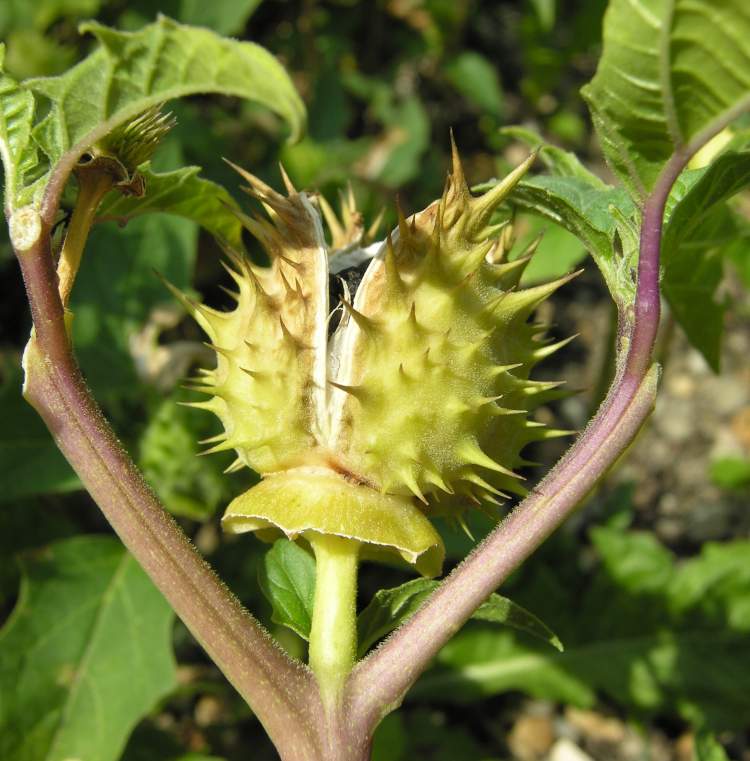

Datura ordinary has found wide application in cosmetology. With it, you can get rid of unwanted hair on various parts of the body. To do this, you need to take 150 g of dry raw materials, pour them with one liter of boiling water, then boil until a homogeneous mass appears. As soon as the broth cools down, it is spread on the desired areas of the skin. Such a remedy has a very long shelf life, while it does not lose its healing properties.
The broth is also used for douching and enemas. To create it, take half a liter of water and a spoonful of dry crushed leaves, cook for 5 minutes over low heat. The finished product is defended for about twenty minutes, then filtered and consumed once a day for three weeks.
The plant is poisonous, therefore, any changes in the body must be carefully studied. If you feel unwell, you should immediately stop using and consult a doctor.
A single dose for a person per day is 0.2 g, a daily dose is 0.6 g.
Historical reference
Where does this herb grow? Unfortunately, the exact place of origin of the common Datura has not been established. The two most popular versions are as follows:
- American history says that the seeds of this plant were brought to Europe from America by the sailors of Columbus;
- The second version - Asian, claims that roving gypsies discovered strange, intoxicating seeds in the steppes located near the Caspian Sea. And then they were taken to all Asian countries.
The herb got its name from the intoxicating effect of narcotic poisons that cause hallucinations. In ancient times, this plant was very popular among healers and sorcerers. In different countries, it has been used to achieve various goals:
- The Aztecs considered herb to be a sacred plant, because with its help it was possible to induce hallucinations, allowing them to communicate with higher powers. The fruits of this plant were sacrificed to the gods;
- Indian tribes used stray grass for witchcraft; In China, dope was actively used by healers and sorcerers in order to cure even the most serious diseases;
- In India, the dancers of the Shiva temple were given wine and dope to induce ecstasy; A European legend said that sorcerers prepared an ointment on its basis, allowing them to fly on a broomstick.
This plant has been overgrown with a large number of various legends and rumors. All of them are associated with its ability to cloud the mind.
Datura oil
The oil is obtained from the seeds of the common Datura. The main application is to eliminate unwanted body hair. Oil, getting into the hair follicle, destroys it from the inside. Therefore, in this place, treated with the product, hair will no longer grow. Apply the drug in this way: first, epilation should be done, after which you need to take a little oil on your palm and apply it with a thin layer on the newly exposed bulbs and pores.
The oil of the plant is also used in the removal of fecal stones from the intestines and stones from the gallbladder. It normalizes the digestive tract, and also improves intestinal motility. In addition, the oil has a soothing agent, due to which it is effective in relieving stress.
It is used externally for burns, radiculitis, eczema and arthritis.
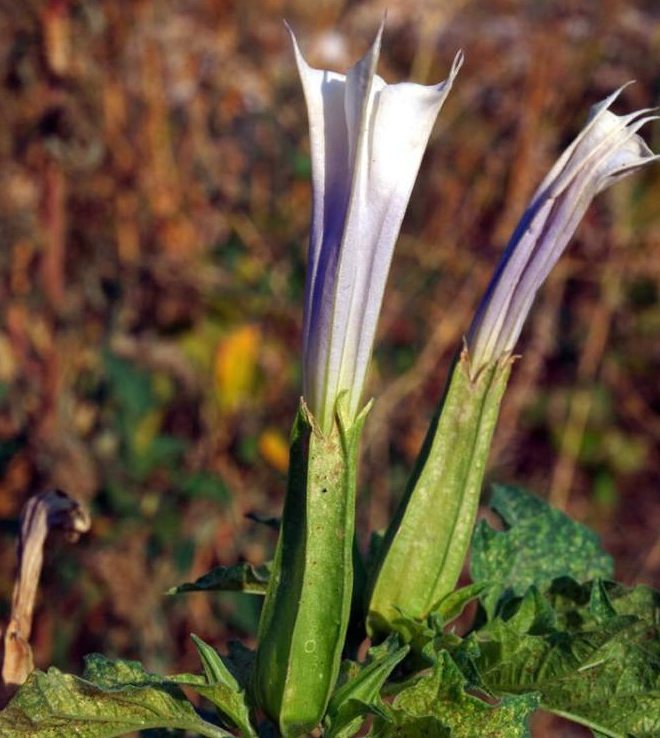

Growing datura from seeds
Datura is most often grown from seeds. Like many plants of the Solanaceae family, its seeds require a fairly high temperature for germination: +23, +25 degrees. At lower temperatures, they hatch much more slowly.
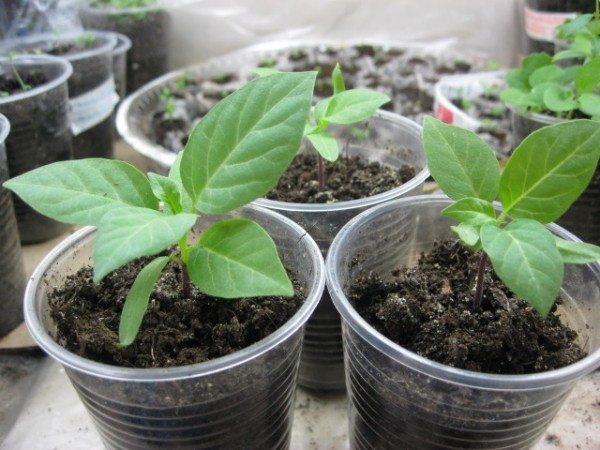

Growing datura by seeds
There are several ways to speed up the process:
- Place the seeds in a concentrated solution of potassium permanganate for 2 hours. During this time, the shell will soften somewhat and the seedlings will appear faster.
- Moisten the seeds well, put in a bag and put in the light, in a warm place. When sprouts appear, sow one seed in a glass. So gradually all the planting material will be used.
- Stratification. This method is only suitable for ordinary dope, which is prone to self-seeding. Its seeds are stratified in natural conditions, and this will help at home. To do this, you need to moisten a cloth napkin, wrap the seeds in it, place in a bag, store for three to four weeks on the bottom shelf of the refrigerator. During this time, microcracks appear on the shell, which will accelerate germination.
The time for sowing seedlings is from February to April. The soil requires light, nutritious. Half a centimeter will be enough to sprinkle the seeds on top. You can sow by seed in a separate cup or in a common container, followed by picking.
You don't need to grow a lot of seedlings. The picture shows how much space is required for one bush.
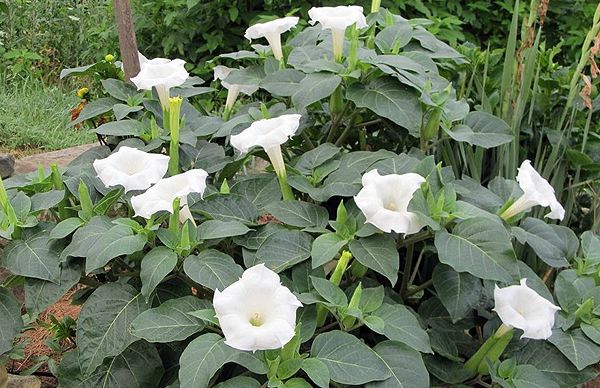

You can sow with seeds in open ground. Sowing time is determined by the weather. Usually this is the beginning of May, when the soil warms up to +18 degrees.
For planting datura, you need to allocate a sunny, calm place. A drainage layer of crushed stone, pebbles or expanded clay is laid in the flower bed. The soil is needed loose, nutritious, with a predominance of compost. In the open air, the soil wears out faster, so the seeds are sown a little deeper, about 1.0 cm.
If you build a greenhouse above the flower bed, then more moisture will remain, the soil will warm up more strongly, and the seeds will germinate quickly and amicably.
Datura cultivation
At the present moment, many gardeners grow this plant, as it is unpretentious, while its flowering lasts for a long time. The soil for its cultivation must be prepared in advance. It is necessary to add humus, earth and sand from the garden to it. It should be cooked in the fall. Spring is the time for planting seedlings and sowing seeds. Sowing is desirable to carry out in small plastic containers, where fresh autumn soil and peat were poured in advance. After 10 days, the first shoots appear.
Next, a manganese solution should be poured into the tray in which the grass seedlings will be located.This remedy will protect the seedlings from fungal infection. Seedlings should be watered regularly, while avoiding stagnation. In summer, you can plant Datura seedlings in the ground, while maintaining a distance of one meter between the plants. Datura, after it grows up, takes up a lot of space. It has spreading branches and is very tall. In order for the plant to develop and grow well, it should be transplanted into loose soil every spring.
Disease and pest control
The appearance of gray fluffy spots on the leaves of the dope means infection of the plant with gray rot, a fungal infection. The development of the disease is favored by the peculiarity of growing datura: the need to keep the soil moist.
To combat gray rot, the bush is treated with:
- 1% solution of Bordeaux liquid;
- antifungal agents;
- infusion of ash, chalk and copper sulfate.
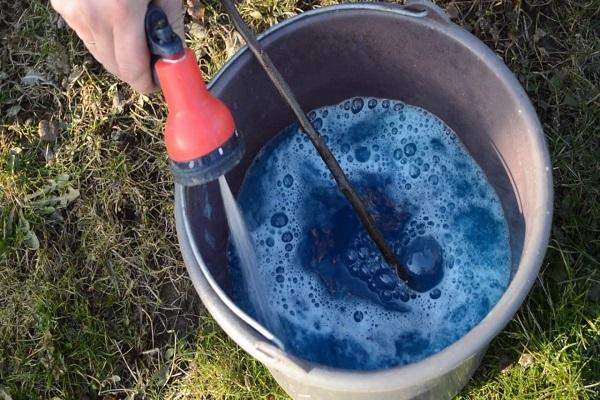

Plant pests are whitefly butterflies and their larvae, false spider mites. The whitefly feeds on plant sap. During the summer, rejection of caterpillars occurs every 25 days. Caterpillars not only suck the juice from the leaves, but also secrete a sticky sweet substance on which a sooty fungus parasitizes. To combat insects, systemic insecticides are used, in the fall they do a deep digging of the soil.
The false spider mite is microscopic in size. You can determine the infection by the dried, brown leaves. As a preventive measure, autumn deep soil cultivation is necessary. When infected, drugs containing pyrethroids, organophosphorus compounds are used.
Datura care
For planting dope, the place should not be very sunny and bright, while protected from the wind. The flowering of this plant depends on the quality of the water used for irrigation. It is advisable to water the dope with hard water, however, if it is not there, then you can use plain soft water. Although in this case it is necessary to water the dope with lime milk once a season.
In summer and spring, the grass grows very actively, therefore, it needs at this time in pruning previously faded flowers and watering 2 times a day. In this case, it is necessary to stock up on seeds that need to be collected from the fruits remaining at the place of origin of the first flowers. To avoid shedding seeds, special bags should be put on the box-fruit.
Grass pests do not like moisture, therefore, the plant must be sprayed with plain water. Sometimes it is sprayed with a solution of pyrethrum.
Popular talks
- Report on the topic Steppe Eagle 2, 4th grade message
The steppe eagle, is one of the largest species of birds of prey, this bird species belongs to the hawk family and the Orlov genus. - Report on the city of Vladimir
The city of Vladimir, named after the prince, was founded in 1108 and had the title of kings. Despite the fact that in the 16th century the city received a provincial status, over time it reaches a level with high culture and education. - Report June Beetle Grade 3 Post
Among the many species of insects that live on our planet, beetles are known to everyone. This is a very numerous order, it differs from others in that beetles have two pairs of wings, one of which is transparent and thin,
Blank
In the form of a drug, not the whole plant is harvested, but only its seeds and leaves. Grass leaves are harvested in dry weather, because when moisture gets on them, they quickly darken when torn off. Then they are dried in ovens at 40 ° C. In addition, the leaves can be harvested when the seeds ripen, in this case they are dried in dark places in drafts.
The drying process is completed when the prepared raw materials are easily broken. Remember, wash your hands well when handling this herb as it is highly toxic. The prepared raw materials can be used for two years for medicinal purposes.
Possible consequences
Datura poisoning when a large amount of toxic substances enters the body is fraught with serious consequences. Disorders in the body can relate to the psyche, nervous system, gastrointestinal tract, etc. The development of certain complications depends on the severity of intoxication and the timeliness of medical care provided.
Mostly, the victims have the following health problems:
- urination disorders;
- prolonged digestive upset;
- vision problems, up to glaucoma;
- chronic fatigue, drowsiness;
- a constant feeling of anxiety and fear;
- deterioration of memory and brain performance in general.


Poisoning
Datura ordinary is a poisonous plant, it should be handled carefully, otherwise there is a risk of poisoning. The possibility of this appears when the seeds are used for food.
Signs of poisoning:
- incoherence of speech;
- dry mouth;
- bloody diarrhea;
- vomiting and nausea;
- difficulty swallowing;
- headache;
- dilated pupils;
- photophobia;
- reddened and dry skin;
- inability to normally see a nearby object, short-term loss of vision;
- impairment of short-term memory;
- hallucinations and delusions;
- uncontrollable laughter;
- tachycardia.
In a severe case, there is a complete loss of orientation, an increase in temperature and sharp agitation, convulsions and shortness of breath, a decrease in blood pressure and a blue discoloration of the mucous membrane. Coma and loss of consciousness are likely. Sometimes death is possible due to vascular insufficiency and respiratory paralysis.
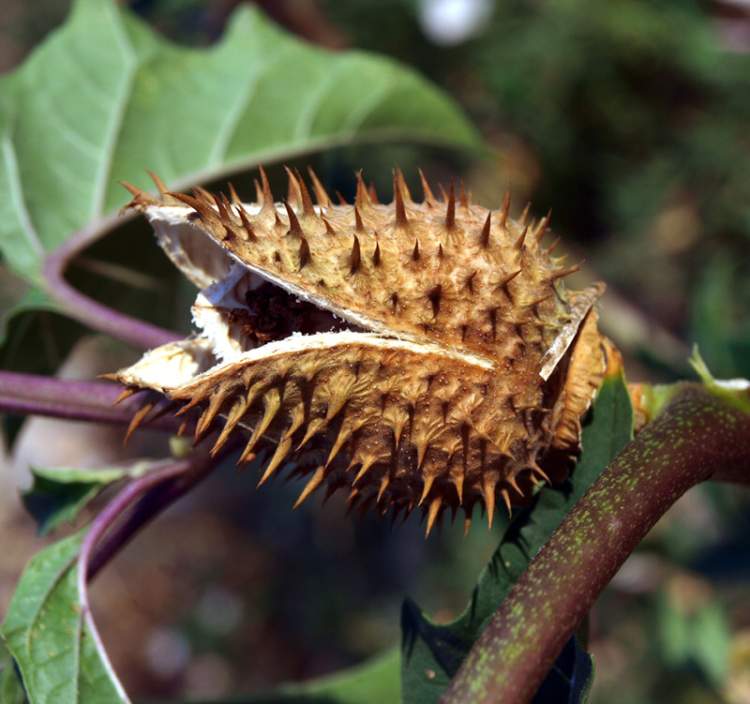

In case of symptoms of poisoning, call an ambulance urgently. For first aid, it is necessary to artificially induce vomiting, as well as to wash the intestines. You can drink some charcoal later.
This effect from poisoning can last up to two weeks. The consequences can be swelling of the legs, forearms and face.
Specialized treatment
Further therapeutic measures are carried out in a hospital setting. In severe cases, the victim is placed in intensive care. To completely eliminate toxic substances from the gastrointestinal tract, procedures such as gastric lavage using a probe or a siphon enema are used.
Further treatment is as follows:
- Administration of an antidote (cholinomimetic). Most often, in case of intoxication with dope, injections or infusions of the drug Proserin are used. Another popular drug is Galantamine.
- For convulsions, Diazepam or Relanium is administered.
- When the temperature rises significantly, Analgin solution is used.
- To cleanse the blood in severe cases, hemodialysis can be prescribed.
- To restore the normal amount of urine and cleanse the body, forced diuresis is performed naturally. For this, alkaline drinks and diuretics are used.
- To stimulate the work of the heart and respiratory system, Cordiamine, Ephedrine and similar drugs are used.
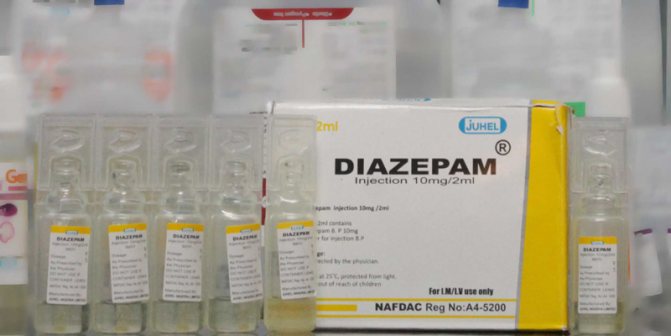

How the plant attracted scientists
Note that information about the dope came from different parts of the world. The Indians have already been mentioned. Let us mention that they used this plant for the manufacture of medicines. The drugs were used for seizures, skin rashes, for the treatment of wounds and in other cases. But in India, it came in handy as a hallucinogen. The Austrians echoed the southerners. It was customary to throw a whole bush on hot coals. The acrid smoke obtained in this way was inhaled and fell into a trance. And if in India this method was part of spiritual practices, then the Austrians were attracted by drug intoxication. It doesn't matter how we feel about it now: we had no idea about the dangers of stupefying substances a hundred years ago. Nevertheless, the experiences of various peoples have attracted the attention of scientists. They began to study the plant, and not just admire its flowers. Datura revealed to them many of its useful properties, which are now being successfully used.
Features of use during pregnancy and lactation
During the period of bearing a baby, a woman should take care of her health as much as possible. But no one is immune from unwanted diseases, and often drug treatment is successfully replaced with folk remedies.
But there is no need to rush to brew and use various familiar herbal mixtures, as this can significantly harm the baby during intrauterine development, and even lead to spontaneous abortion. Datura herb poisonous substances can cause a sharp reduction in oxygen in the mother's blood and cause fetal asphyxia or death.
It is important to follow the doctor's recommendations, who individually selects the dosage of the herb for everyone.
Collection and storage
During the period of abundant flowering from July to September, the aerial part of the grass is collected, mainly the leaves, and the seeds only in October. Unripe seeds contain scopolamine, a drug used in patients with lingering depression, which provides quick and long-lasting relief. Hands should be protected from contact with the grass, gloves are suitable.


Correct drying of raw materials should be carried out at temperatures up to 50-60 C. To preserve all the medicinal properties of Datura, seed boxes are best opened at maturity in September. A glass jar with a hermetically sealed lid is suitable for storage. Any contact with grass should end with soap and hand washing.
Reproduction of a plant at home
In the case of datura, propagation by seeds or cuttings is used. To harvest the seed, remove the seed pods after the first flowers have wilted. For 2 months they should be placed in a dry and dark place. Make sure that the box does not crack and the seeds do not fall into the ground. The shrub in this way willingly reproduces by self-seeding.
For cuttings, cut off a part of the shoot with a couple of internodes. Further:
- cut all large leaves in half;
- prepare light soil;
- soak the stalk in a root stimulant.
Advice. Reproduction by cuttings is usually carried out in September or mid-March, with spring planting on the site.
Application methods
Very often, Duropian is taken in the form of a powder from dry leaves, which is smoked for asthma, and with a convulsive cough, it is taken orally three times a day at the tip of a knife.
Decoction
Datura in the form of a decoction is effective for local baths (20 g of dry mixture per bucket of water), eye lotions and compresses (20 g per glass of water). Inhalation of its vapors is used when coughing.
Tincture
Most often, a tincture is used for treatment, which is taken three times a day, 25 drops in 100 g of water.
It is prepared as follows:
- dry grass is poured with alcohol in a ratio of 1 to 5;
- aged for 5 days.
The tincture has antitumor properties, in which not the herb is used, but the seeds of dope. It is used internally (2 drops in a spoonful of water), and in a diluted form - for rubbing.
An oil tincture in which the seeds are used helps in the removal of fecal stones and is also used externally for the treatment of eczema.
Seeds
Vegetable oil mixed with crushed grass seeds is used for hemorrhoids, radiculitis, arthritis. Indian medicine for impotence recommends rubbing such a remedy into the genital area and soles.
Harm and contraindications
Since dope herb is a poisonous plant, its use is contraindicated for persons with the following diseases:
- glaucoma;
- arterial hypertension;
- chronic ailments of the heart, liver and kidneys;
- ulcerative colitis;
- intestinal atony;
- prostate adenoma.
When using drugs that include a poisonous plant, the dosage should be observed, otherwise the onset of poisoning is possible, accompanied by the following symptoms:
- the skin becomes dry;
- dry mouth and thirst;
- nausea and vomiting;
- intermittent pulse.
In some cases, hallucinations, seizures and loss of eye response to light may occur.
Datura herb is both useful and dangerous plant, the main advantage of which is the ability to relieve severe pain.
Be careful!
Whatever the medicinal properties of this plant, dope is very poisonous. Experts do not recommend using it in cases where you can get by with more gentle means. If a thick decoction, tincture or oil is used to remove hair, it is necessary to test for sensitivity to this plant. In any case, the plant is strictly contraindicated for pregnant women, children and persons suffering from glaucoma.
Unfortunately, cases of poisoning with this plant through negligence (and sometimes deliberately by children and adolescents) are not so rare. Warning signs are dry mouth, increased heart rate, dilated pupils and blurred vision, and lethargy or agitation. At high doses, hallucinations, incoherent speech, and coma may develop. If there is poisoning with dope, it is necessary to rinse the stomach with a weakly acidic solution, take activated charcoal and urgently seek medical help.
An annual plant that grows in large quantities in Western Siberia and the Caucasus is called Datura grass. People call it for its toxicity "divderevo", "thistle", "crazy grass", "stupid grass", "stupid potion", "cocklebur", "prickly apples", "badura". It is believed that one touch of this plant can provoke skin inflammation. Is it so? We will understand the article.
Description
It is a straight stem with a powerful white rhizome, leaves with sharp teeth. If you rub the sheet between your fingers, an unpleasant specific smell arises. White flowers bloom from the axils of the leaves, they also have a strong aroma.
The fruit of this plant is similar in shape to an egg, on the surface of which there are small green thorns. Inside are large black seeds, with the help of which Datura multiplies. They ripen by October, and it blooms from July to September.
What parts are used
From July to September, dope leaves are harvested, which are actively used in various fields. Harvesting is done up to 4 times during the growth period. Then the raw material is dried very quickly at high temperatures in special dryers. In our country, the procurement of raw materials is carried out only in the Krasnodar Territory.
Datura herb: beneficial properties
Datura leaves have a therapeutic effect due to the content of alkaloids in the composition. They are used in the following cases:
- with a strong cough, it relieves spasms of the muscles of the bronchi;
- with bronchial asthma;
- for the treatment of neuralgia, rheumatism.
The use of dope in folk recipes
On the basis of the leaves, infusions and extracts are prepared, plant seeds are used in the creation of tinctures for asthma. Datura is used in the following cases:
- To maintain the nervous system in case of mental illnesses, it neutralizes the manic state.
- Vodka tincture is used for paralysis and severe shortness of breath.
- The decoction is taken for epileptic seizures.
- For eye inflammation, decoction lotions are used.
- Pain reliever for toothache.
- For rheumatism, for rubbing.
In the old days, horses were rubbed with grass so that gadflies did not appear. They fumigated her infectious patients.
Preparation of medicines and infusions
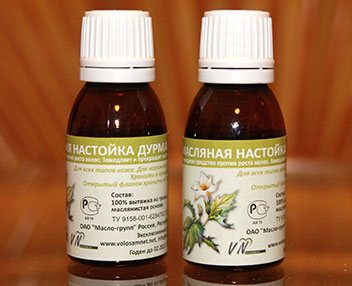

To create a tincture, you need to take 100 g of the seeds of this plant, grind them, pour 0.5 alcohol. Close the container and put in a dark place. After a week, strain the tincture. It is used as follows:
- For inhalation for asthmatic conditions and coughing - up to 20 minutes;
- For the treatment of insomnia - 2 drops per 30 ml, taken several times a day;
- Inside - 25 drops per 50 ml of water on an empty stomach for a month to prevent strokes and thrombosis.
You can prepare a decoction of the herb for the bathroom. To do this, 20 g of dried leaves are brewed in 12 liters of boiling water and infused for half an hour. The finished infusion is poured into the bath water.
A decoction for the treatment of tumors and mastitis, inflammation of the lymph nodes and mastopathy is taken in a teaspoon for half a glass of water. To prepare it, you need to take 1 tsp for a glass of boiling water. plant seeds.
Also, this broth can be used to gargle with diseases of the oral cavity.
To prepare lotions for eyes, dilute 2 tsp in a glass of water. broth.
Contraindication to use
It should be borne in mind that dope is a very dangerous plant. Therefore, before use, you should consult a doctor and take drugs with this very carefully, following all dosages. Otherwise, signs of poisoning appear:
- diarrhea with bloody discharge;
- memory losses;
- pupils dilate;
- dry mouth.
They can appear within the first 10 minutes after ingestion. If such symptoms are observed, it is imperative to call an ambulance and do a gastric lavage. Pupil dilation is observed up to a week after poisoning.
Do not use drugs containing dope:
- During pregnancy and lactation.
- With glaucoma.
The magical properties of dope
According to legends, in ancient times, the devil drove alcohol from this dope-herb in order to add people to sin. He agreed to the proposal of God that all the souls of dead people from vodka will belong to him, so the devil makes every effort to get people to use this drink.
Sorcerers, priests and used the herb for clairvoyance rituals, she helped to see the future. It was believed that dope allows you to cause visions, resists evil spells and bad conspiracies.
Datura was also used as a hallucinogen and was spread by nomads. Many in their plots burned grass in fires in order to get a wonderful smoke that allowed them to relax, lead to a blissful state, simply intoxicate.
Some peoples added herb to smoking pipes or drinks to achieve a state of euphoria. This herb was used to poison politicians.
An annual plant of the Solanaceae family.
Occurs on loose, moist soils near home, in fields, along slopes and ravines. It grows on the territory of Ukraine, in particular the Crimea, the Caucasus, western Siberia.
Among the people, there are other names for herbs such as: drunk cucumbers, korolki, stupor grass, thistle, durnopyan, etc.
The plant sometimes causes very strong hallucinations. Since ancient times in India, shamans have used for their rite. In ancient times, in some countries, the herb was used as a narcotic substance.
Description: Although the homeland of Datura is Asia, it is well adapted to the climate of Central and Eastern Europe. Grown in gardens as an ornamental plant. Has a highly developed root system. Powerful rod root of white color. Flower height reaches 120 cm. Straight stem and large leaves with an unpleasant odor. The flower itself is considered poisonous.
The leaves of dope ordinary at the end are pointed, ovoid, narrowed at the petiole, dark green on the front side, the underside is lighter.
Datura has large, single, white, or purple, funnel-shaped flowers. Flowers appear from June to September and have an unpleasant odor (especially at night). Flowers reach 12 mm in length.
The fruit is in the form of a round, erect capsule, which is covered with sharp thorns up to 1 cm long. One box contains over 500 seeds.
Seeds are black matte, slightly flattened, large.
Datura is propagated by seeds.
The sowing period is early spring, the seed ripening period is from June to October.
Datura ordinary blooms: June - September.
Description
Many people have heard of such a plant as datura. However, not everyone knows what this flower looks like.
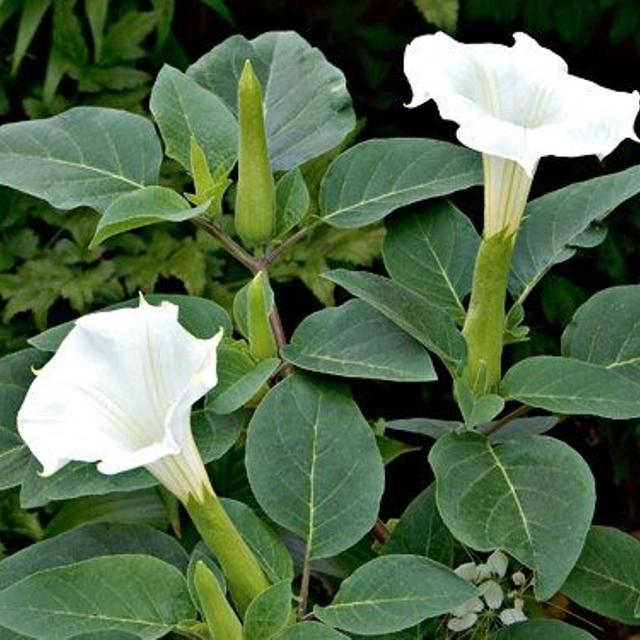

Datura is a perennial evergreen herbaceous shrub. He loves a warm climate, so it grows in tropical and subtropical climates. However, in our country, this plant is successfully cultivated by gardeners. In the wild, Datura prefers to grow in mountainous and steppe regions. In our climatic zone, the flower is grown as an annual plant.
The description of the herb datura should be considered in more detail. Plant stems can be lodging or erect. Their length is 50-120 cm. The plant feeds a cream-colored rod rhizome. The stem is hollow, tubular, covered with reddish or dark green bark. Over time, the base of the shoots lignifies, acquires a brown-red color.
The leaves of the plant are large, oblong, with jagged edges. Each of them grows on a long petiole. The length of the leaves reaches 15 cm, the width is 10 cm. A light stripe runs along the central vein on it. Leaves are dense, leathery, have a smooth surface. The reverse side is light.
Considering the description of what the Datura herb looks like, it is also worth noting that the flowering of this plant deserves special attention. It is for the beauty of its buds that it has become so widespread, and is also called the "angel pipe", "moon flower", "bleached". However, for its poisonousness, the flower also receives other names, for example, "crazy grass", "drunken cucumber" and even "devil's grass".
Collection of planting material
As practice shows, the best germination results are given by seeds at the place of appearance of the first flowers. This means that they are best used for breeding.
After the seeds are ripe, the seed pods begin to open. Here you need to not miss the moment, otherwise the seeds will begin to spill out. It is better to foresee this moment and put a gauze bag on them. It will not interfere with the movement of natural processes, but the seeds will be completely intact.
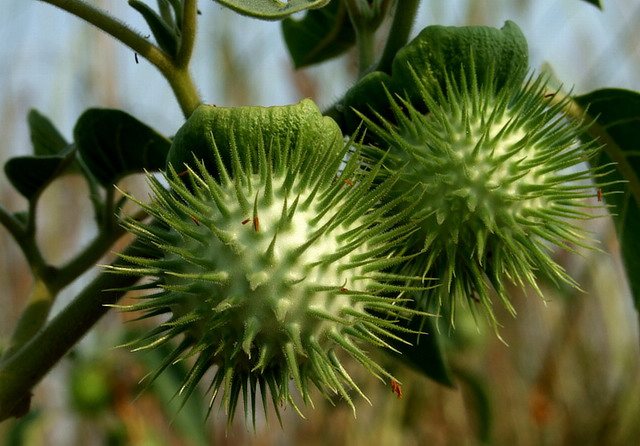

Seed capsule
Seeds remain viable for a long time, but every year it will become lower and lower.
Motion sickness mixture
Powder or alcohol tincture, the recipe for which was described above, will help from the first signs of seasickness.
Ingredients:
- Datura dry leaves - 10 g;
- Water - 250 ml.
Recipe:
- Powdered dry grass leaves.
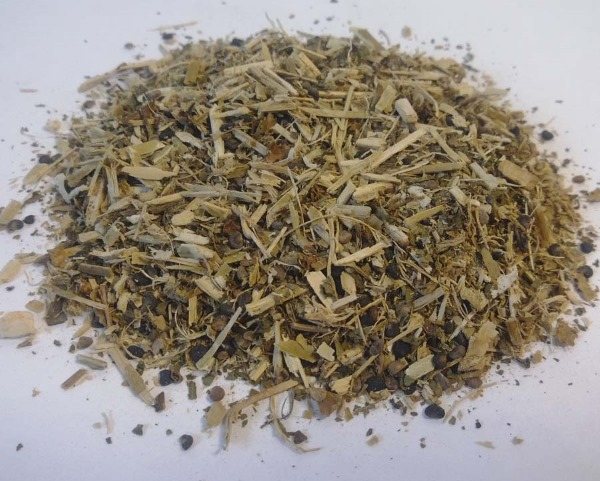

- 1⁄2 spoon of dried herb is diluted in a mug of water.
- Drink as needed.
Germinate seeds faster! ↑
Planting and growing datura is very easy! There is a huge amount of seeds of all kinds on the market of planting material. Any self-respecting company will surely hide the cherished 3-4 seeds in a multi-colored bag.
The seeds are rather large, covered with a dense seed coat. Germination rate is very high - 95%, lasts up to 10 years.
One obstacle is that it usually takes a very long time to wait for the first shoots, sometimes up to 30 days.
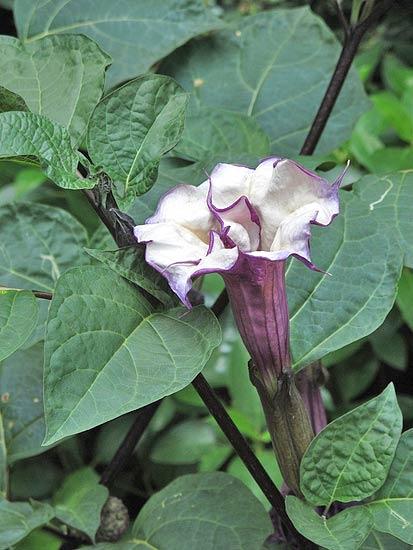

To rush the cute miracle of nature a little, you can soak the seeds in cool water or a growth stimulant solution for a couple of days. This will help loosen the tight bonds of the seed coat a little and give the light of new green life more quickly. Practitioners recommend using a zip pack with a little water. Place the seeds there and wait until they hatch, then boldly plant them in the ground and enjoy the shoots.
Asthma remedy
Datura herb, photo and description of which can be found on the Internet, has long been used in traditional medicine recipes. And in the treatment of bronchial asthma, this medicinal plant will quickly help.
At the moment, there are 3 ways to deal with the disease:
- A mixture of 7 parts of dope leaf powder, 1 part of henbane, 1 part of sodium nitrate, 2 parts of belladonna leaves. This powder can be burned and inhaled, or smoked like a cigarette.
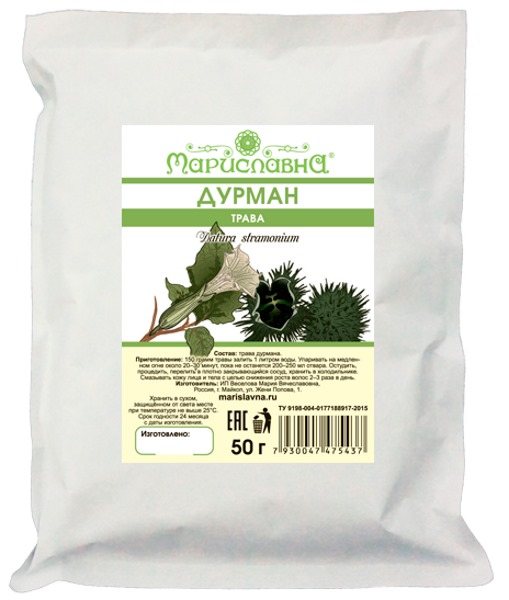

- Cigarettes called Astmatin are produced - 2 parts of henbane, 1 part of sodium nitrate and 8 parts of dope.
- Datura leaf decoction is used to inhale vapors through the nose. The principle is the same as in the boiled hot potato treatment.
Security measures
During the procurement of raw materials, certain safety measures are adhered to. This plant should not be picked with bare hands. Be sure to use rubber gloves. It is strictly forbidden to dry dope at home, all the more to use an oven for this purpose.
Collected plants need to be divided by selecting leaves, seeds, flowers separately. Medicines from them are also prepared separately. Jars of plant material should be tightly closed. Blanks are stored in this form for up to 2 years.
Even if the work was carried out with gloves, hands should be washed well with soap after the procedure, preferably several times. If there are small children in the house, it is unacceptable to store such blanks in accessible places.

